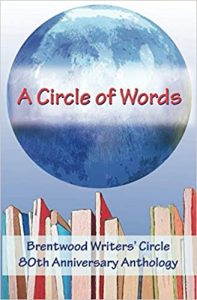Friday Features: A Way To Showcase Your Work
Patrick Forsyth reviews the rewarding process of producing an anthology
Most writers want to be read – and be published – and publication may not be easy to achieve. Of course, it is possible to self-publish, though widespread sales are uncertain and the whole process is likely hard work. So for members of a writing group producing an anthology can be an attractive proposition. Brentwood Writing Circle, a group with around fifty members, had their 80th anniversary arriving in 2021 so this seemed to present a good moment for such a venture.
I was in the Chair at the time and set this out here to record our experience, to encourage others towards similar projects and perhaps to issue a warning; it is not quite as easy as one might initially think. So what did we do – and learn – and what should others taking this route bear in mind?
Our first thought was that the detail of what was to be involved was too complex to be easily seen through by our full committee; remember the old saying: the ideal committee is two, with one absent. So I was deputed to lead the project together with one other committee member, Laura Burkin. Regular progress reports were given to the full committee which was involved in key decisions. Despite a few hiccups, by and large, that worked well. The prime stages were as follows:
- Theme for entries: there might well have been no theme, but having had a small grant from the Brentwood Arts Council, we decided to have pieces linked in whatever way to “the arts” and to include both fiction and non-fiction
- Timing: we worked back from an ideal publication date and set a deadline for submissions to be received (although we were firm, I admit we did extend the deadline a little as some members were late)
- Invitation: telling members how to make a submission and specifying word count, typeface, delivery method etc. Any ambiguity can cause misunderstandings
- Reality check: delicately making it clear that not everything submitted can be guaranteed to be included both on quantity and quality grounds
- Size: the extent of the book and cost go together. Our choice: large enough to be a real book (with a spine), not so large that costs are prohibitive
- Choice of production process: we went with Amazon, in part because we had a member who knew the process (other systems are available…)
- Cover: one member with some design experience was depute to design the cover, though simpler ways are possible, for example, a huge range of designs are available from online photo libraries and the like. The blurb was written by one of the project duo and edited/approved by the other and suggestions were sought from all members for a title (which the full committee decided by vote)
- Introduction: again the project team created this
- Proofing: as submissions came in a surprising number of typos was found. Once the manuscript was put together (project duo again) the full committee read it, and did so again when proofs came in book layout form from Amazon. Note: we were still finding things right through the process, so if we learnt anything it was that proofreading needs to be done very, very carefully; be warned
- Amazon: the procedure there takes a little working out (especially to get the cover laid out neatly); we were lucky to have someone who had been through it before. Alternatively, allow enough time or pay an expert to actually turn the Word manuscript into book format (it is not a long or expensive job for someone used to it)
- Book: first we had a proof book (actually more than one) and with that right, we pressed the button as it were and a quantity of copies duly arrived.
Clearly, some of these stages overlapped. Let’s not forget a major stage: the writing. Individually members worked hard to create and submit their best work; the lead time needs to accommodate that too.
We are delighted with the results and feel the book looks great, and of course, we also feel the content is good too. It is nice for members to see their work in this form, and, for the group, we set a public sale price on Amazon (from where anyone can buy) and sell copies to members at a discount from that and from which we still make a small margin to help fund the group’s activities. Having the book now gives the group something to show non-members and prospective members and may be helpful in recruiting new members (there is a page at the end explaining the group’s intentions and activities).
The process was a little more complex than we initially thought, but the results were certainly good – and worthwhile – doing it was not too time-consuming and I would say here that anyone could do it with a little planning and care. There were many stages and decisions along the way and, in my view, it is not something to drive through via a full committee (there is a danger that everything is then played safe and becomes bland if everyone is kept happy). That said, while during such a project people might have disagreed on details, I think I can safely say that the whole group found it worked out well in the end.
We are pleased we did it; perhaps you are a member of a group that could give it a go. It’s worth a thought. Final advice: don’t underestimate how long it will take or its complexity; each individual stage is pretty straightforward, but a bit of planning and juggling is necessary to make it come together. Do it and you have a lasting reminder of a group’s work and a tangible asset to use in promoting its activities.
*****
Note: * The anthology, titled A Circle of Words is now available from Amazon, but if you want to check out Brentwood Writers’ Circle come along as a visitor when meetings start again and you can pick up a copy then. Check out the website: www.brentwoodwriterscircle.org for dates.
Circle come along as a visitor when meetings start again and you can pick up a copy then. Check out the website: www.brentwoodwriterscircle.org for dates.
Patrick Forsyth writes in a variety of genres, his third novel, A Rather Curious Crime, was in the final stages of writing and production while the Anthology project was in train, but is published and available now.
*****
The process was a little more complex than we initially thought, but the results were certainly good – and worthwhile.




